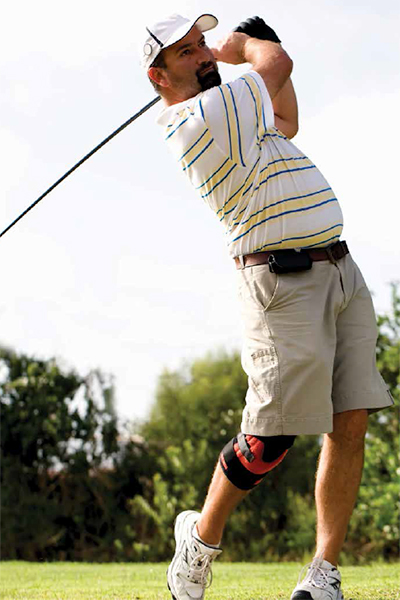THE THINGS YOU ‘KNEE-D’ TO KNOW TO GET BACK IN THE SWING OF THINGS
Story by Nikki Villoria
Las Vegas Golf & Leisure Magazine
 From the surgical table to the golf course in a matter of six weeks: for some, this sounds like nothing more than a fantastical dream come true, for others it’s their reality. With new advancements in technology, implant prosthetics and more proactive physicians, the drawn out down time from knee and hip replacement surgeries is something of the past.
From the surgical table to the golf course in a matter of six weeks: for some, this sounds like nothing more than a fantastical dream come true, for others it’s their reality. With new advancements in technology, implant prosthetics and more proactive physicians, the drawn out down time from knee and hip replacement surgeries is something of the past.
“How quickly people get back up and walking and back in their normal routine is ultimately up to them. We establish a physical postop routine that gets them walking down the hall just two to three hours after their surgery, walking 1,000 feet the day of the operation and within two weeks about half of them can take a swing out at the golf course already,” says Dr. Michael Crovetti, orthopedic surgeon, sports medicine physician and founder of Crovetti Orthopaedics and Sports Medicine in Henderson, Nev.
Patients’ quick recovery times are due to physical therapy. To prevent muscle atrophy, weakness and fatigue during recovery, Crovetti requires patients to make a physical therapy commitment of one hour a day for hip replacement and two hours a day, twice a day for knee replacements for the first four to six weeks after surgery. By requiring patients to return to a physical exercise program almost immediately, the body is not given the chance to become stiff and sore and thus patients are able to keep pain to a minimum and get back to their normal routine in a fraction of the recovery time with an increase in mobility and range of motion. Like the recovery time, surgery times are also shorted due to advancements in surgical instruments and techniques, including minimally invasive surgeries, which include three and four-inch incisions and no cutting of the muscles, and more durable, long-lasting plastic implants. In comparison to standard replacement surgeries, which take one to two hours, these modern replacement surgeries are now done in 45 minutes. Like all surgeries a physical toll is taken on the body through the recovery process, however the physical aspect is only half the battle.
“There are so many people who are just not mentally ready for the procedure. Physically they can’t walk, they’re not playing golf, they’re in pain every day and are in pain with everything they do but mentally they’re not committed to have the procedure done because they don’t know what it is,” says Crovetti. “People always hear all the horror stories, but I can tell you of 100 people who play the exact same sport and tell them what the outcome is going to be to a very high degree of accuracy. This week, I have a 36-year-old coming up, a big wakeboarder and snowboarder who has completely trashed his knee. He can’t wakeboard, can’t snowboard, we’ll replace his knee and after he has his surgery he’ll be back snowboarding by this winter season. Like most people, he didn’t know what his results would be until he came in and got educated. Things like the Internet are great, but only if people are going to the right places.”
Crovetti and his team are on the leading edge of the new surgical turn around. With the elimination of complications and safe and quick recovery processes, Crovetti sees that it is becoming the standard of care for post-op rehabilitation, and surgeons around the country and the world are beginning to gain steam toward this new process. While knee and hip replacement surgeries continue to help or the lack of them continues to hinder individual’s quality of life, when it comes to making a medical or surgical decision education is paramount.
“If there’s a closing line of advice that I can give people with bad hips and bad knees it’s ask questions and listen to the answers. Have the conversation, get educated and then make the decision, because I think most people will find it to be very, very enlightening and inspirational,” says Crovetti. “The surgeon doesn’t make the decision. We treat patients not x-rays. It’s a quality of life decision that the patient has to be mentally ready to make.”




